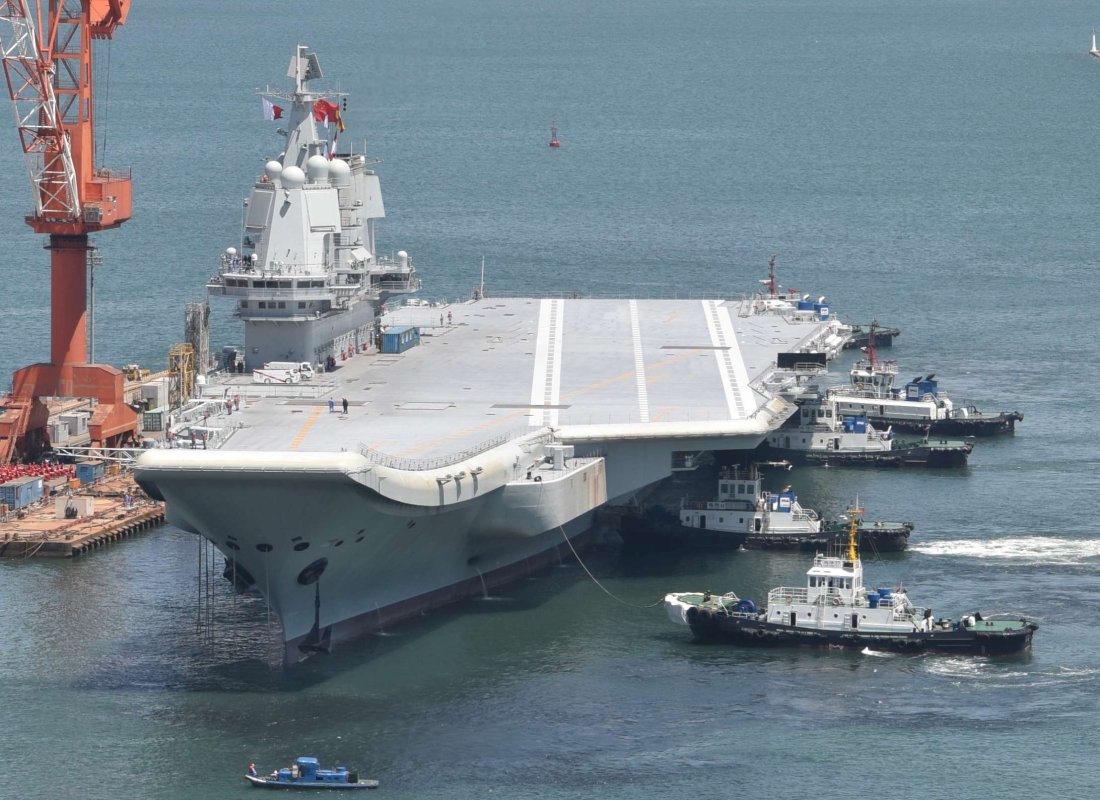It is not clear when the Type 002 will be launched and eventually commissioned, but the Chinese are thought to have a set a goal of having four carrier strike groups in operational service by 2030.
By Dave Majumdar
China has apparently started construction of its third aircraft carrier, but details about the new vessel are scant.
However, unlike the two previous Chinese carriers, the Type 001 Liaoning—formerly the Soviet Kuznetsov-class Varyag—and the Type 001A Shandong, the new Type 002 ship will be equipped with catapult launch systems similar in concept to those found onboard U.S. Navy vessels.
The Chinese are known to be working on the development of an Electromagnetic Aircraft Launch System (EMALS ) hardware similar to those found onboard the latest USS Gerald R. Ford-class aircraft carriers, but development of those advanced electromagnetic catapults has proven to be difficult even for the United States.
The Chinese are known to be working on the development of an Electromagnetic Aircraft Launch System (EMALS ) hardware similar to those found onboard the latest USS Gerald R. Ford-class aircraft carriers, but development of those advanced electromagnetic catapults has proven to be difficult even for the United States.
According to Chinese media, Beijing intends to forego conventional steam catapults and move directly to EMALS technology.
Assuming, that the Chinese are moving forward with an EMALS-equipped vessel, it is an indication that Beijing’s third carrier will be of an indigenous design—albeit one likely aided by technology gleaned from the United States through espionage.
“China is expected to begin construction on its first catapult-capable carrier in 2018, which will enable additional fighter aircraft, fixed-wing early-warning aircraft, and more rapid flight operations,” reads the Pentagon’s 2018 report to Congress on the Chinese military .
Indeed, Chinese media reported earlier this year that the Shanghai Jiangnan Shipyard Group was given the green light to start construction on China’s third carrier.
“China is expected to begin construction on its first catapult-capable carrier in 2018, which will enable additional fighter aircraft, fixed-wing early-warning aircraft, and more rapid flight operations,” reads the Pentagon’s 2018 report to Congress on the Chinese military .
Indeed, Chinese media reported earlier this year that the Shanghai Jiangnan Shipyard Group was given the green light to start construction on China’s third carrier.
“But the shipyard is still working on the carrier’s hull, which is expected to take about two years,” a Chinese defense industrial source told the South China Morning Post .
“Building the new carrier will be more complicated and challenging than the other two ships.”
There are few specific details available about the specifications of the Type 002.
There are few specific details available about the specifications of the Type 002.
However, Chinese media have suggested that the new vessels would displace roughly 80,000-tons, which is comparable in size to the now-retired USS John F. Kennedy (CV-67).
At a displacement of roughly 80,000-tons, the prospective Chinese aircraft carrier would be similar in size to the nuclear-powered Project 1143.7 Orel-class design, the only example of which, Ulyanovsk, was scrapped on the ways after the Soviet Union collapsed at the end of 1991.
Given that China acquired Liaoning and all of her blueprints from a newly independent Ukraine, it is possible that Beijing also acquired the design for Ulyanovsk from Kiev under a similar arrangement.
Given that China acquired Liaoning and all of her blueprints from a newly independent Ukraine, it is possible that Beijing also acquired the design for Ulyanovsk from Kiev under a similar arrangement.
Beijing’s engineers would have benefited greatly from the acquisition of such technology from the fragmented remains of Soviet Union, having never previously designed or built a combat vessel of such a massive scale.
Moscow had completed development of most the critical technologies—such as steam catapults—needed for a fully capable carrier on Ulyanovsk before the implosion of the Soviet state.
Even if Beijing did not obtain the design for Ulyanovsk, the Chinese are clearly benefiting from Soviet technological developments that they gleaned from Liaoning.
Even if Beijing did not obtain the design for Ulyanovsk, the Chinese are clearly benefiting from Soviet technological developments that they gleaned from Liaoning.
Indeed, Chinese media is reporting that Ukrainian engineers have been assisting Beijing’s shipbuilders with the development of the new carriers.
“China has set up a strong and professional aircraft carrier team since early 2000, when it decided to retrofit the Varyag to launch as the Liaoning, and it hired many Ukrainian experts ... as technical advisers,” a Chinese defense industry source told the South China Morning Post.
Nonetheless, there are indications that Beijing is looking towards the West for inspiration for the Type 002, particularly for the design of ships’ topsides.
Nonetheless, there are indications that Beijing is looking towards the West for inspiration for the Type 002, particularly for the design of ships’ topsides.
“The new vessel will have a smaller tower island than the Liaoning and its sister ship because it needs to accommodate China’s carrier-based J-15 fighter jets, which are quite large,” a Chinese defense industry source told South China Morning Post.
“It has been suggested that they look to Britain’s warship, the HMS Queen Elizabeth, which has two small tower islands on the deck. That would create more space for the runway and aircraft, but no final decision has been made yet.”
It is not clear when the Type 002 will be launched and eventually commissioned, but the Chinese are thought to have a set a goal of having four carrier strike groups in operational service by 2030.
It is not clear when the Type 002 will be launched and eventually commissioned, but the Chinese are thought to have a set a goal of having four carrier strike groups in operational service by 2030.
Aucun commentaire:
Enregistrer un commentaire